Trending
Opinion: How will Project 2025 impact game developers?
The Heritage Foundation's manifesto for the possible next administration could do great harm to many, including large portions of the game development community.

Featured Blog | This community-written post highlights the best of what the game industry has to offer. Read more like it on the Game Developer Blogs or learn how to Submit Your Own Blog Post
With 10+ entries, the "Saga" Series has been Square Enix's special side project since 1989. Here are some of the characteristic features that have earned it a passionate fan-base and kept the series going.

This is reposted from my blog at gamemakeworld.wordpress.com.
Romancing SaGa is a unique series of Japanese RPGs spanning from 1989 all the way to 2012. It focuses in on the core elements of what makes RPGs fun: exploration and discovery in a world that gradually unfolds before you.
(DISCLAIMER: I haven’t completed every SaGa game and am focusing on the ones I know best: Romancing SaGA 1-3 (SNES), Minstrel Song (PS2), and Unlimited Saga (PS2))
These classic “SaGa” elements appear in most of the games:
① Characters learn special moves randomly* in the middle of battle.
② There are no experience points (characters’ abilities improve randomly* after each battle).
③ HP is fully replenished after every battle, but characters have Life Points (LP) that determine how many times they can get KO’d before they are permanently dead.
④ Enemies change to match your level throughout the game.
⑤ Large number of recruitable characters (including a choice of main characters), and a loose story with minimal dialogue.
⑥ Order of events and quests mostly left up to player.
*Not literally random, but a lot of chance is involved.
In short, every battle is new and surprising since enemies match your level and there’s always a chance characters might grow stronger somehow. The game is open-ended enough to feel like you are exploring, but provides enough structure and juicy tidbits to stimulate your imagination and bring the world to life.
LIGHTBULBS & SURPRISE IN EVERY BATTLE
A few key elements make the battle system delightful, setting it apart from the basic JRPG turn-based model.
One is the lightbulbs. Sometimes, especially when facing a difficult enemy, a lightbulb flashes over a characters head and, instead of doing what you instructed them to do, the character learns a new move and performs it on the spot. In early games, characters yell the name of the move in a speech bubble, which, coupled with the rough translations of the 90s, was really endearing. I fell for Romancing SaGa 3 the moment my character suddenly yelled “Big Logs Chop!” and wailed on the enemy with an axe.
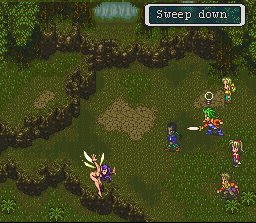
Julius learned “Sweep Down,” a long sword technique! (RS3)
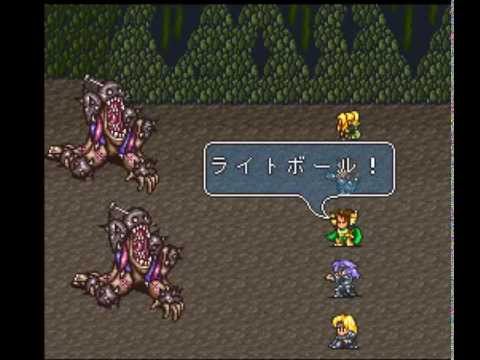
It’s in Japanese, but he’s casting “Light Ball” (RS2)
The lightbulb flash gives you a burst of adrenaline each time (or dopamine? I don’t know my psychological chemicals. Probably both.) and keeps even random battles fresh and exciting, since, although it happens most often in boss fights or against tough enemies, it can happen at any time. This eases the issue of grinding that plagues many RPGs.
Additionally, when the battle is over, characters may gain a level in their weapon or magic, or gain HP, TP or MP (the games use separate Points for magical and non-magical attacks, which means that all characters have an array of special moves and Points to manage whether they are a fighter or mage).
When a character improves their abilities at the end of battle, he or she also does a little jig (spinning and kicking in the SNES versions, or a character specific victory move in Minstrel Song). This spinning kick of the SNES games was a really nice touch. It’s kind of a random (spin, kick, and freeze in mid-air), but really makes you feel awesome when they yell “HP UP!” Also, each character has their own “kick” sprite (which is actually true for every sprite- no two characters punch or kick alike!). Since every character can technically equip any weapon or magic and perform any skill, their unique set of sprites gives otherwise interchangeable battle skills some personal flair.
EVERY BATTLE IS IMPORTANT IN THE DUNGEON-LONG STRATEGY
The unique take on LP, HP, BP/TP, and MP (I know, its a lot of Ps!) also serves to increase the strategy of battles and the entire dungeon.
Battles can be quite tough, so you generally need some characters need to use special abilities to survive. Simply mashing “Attack, Attack, Attack” won’t work. At the same time, the fact that HP is fully restored in between battles let’s you ignore healing (a pet peeve as you may have guessed from previous posts), and you can begin each battle and its strategy from the same state.
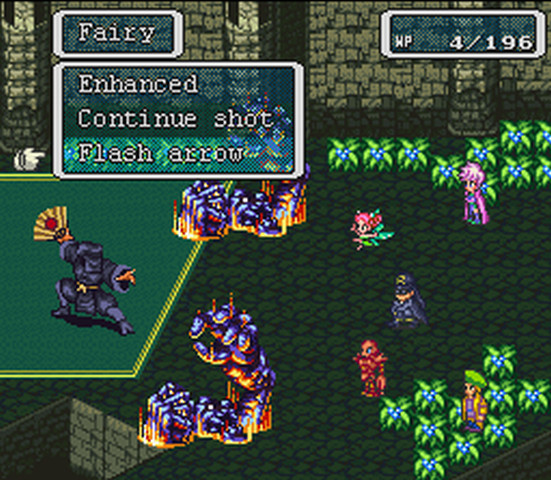
Fairy has learned two bow techniques (the bow itself is called “Enhanced”) (RS3)
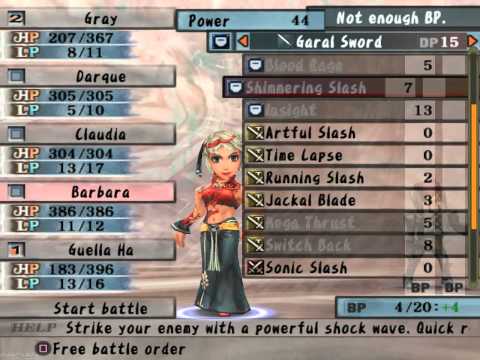
All of Barbara’s sword abilities (Minstrel Song)
Romancing SaGa games are also the only games I have ever played were KOs don’t require special “Life” magic. The usual healing spell brings characters back, which makes being KO’d strangely inconsequential. As long as a character has LP left it doesn’t matter- they’ll be alive again after the battle, HP and status fully recovered. (Though they do lose LP upon each hit while KO’d, which makes you feel really bad…)
Balancing the use of MP and TP with your remaining LP thus becomes the main focus. Nothing like making it to the boss with just a few LP left and hoping you can spark (ie lightbulb flash) some big new techs to survive! In worst case scenario, enemies can be avoided since they are visible onscreen and only have to be fought if you come in contact with them.

Beautiful character and monster design of Unlimited Saga… Those tree guys are hard on the LP, though
STORY & WORLD
I love the “SaGa” approach here, which falls somewhere between linear and open-ended. The way it works is that, you can go to any location that you have heard about through the story or dialogue. For example, maybe someone in that first town mentions a neighboring city, while another talks about a mine that has been infested with monsters. These two locations can now be selected on the world-map, while the rest is completely blank.
Depending on what order you do quests and where you decide to go, your path through the world will be quite different. This works because enemies in each dungeon match your level- their sprite tells you the enemy type (demon, blob, undead, etc.), but your level determines whether you face a measly lone zombie, a gang of zombies, or a terrifying lich king.
Each location and quest offers tidbits of story that, pieced together, give you a sense of a larger story and world. Since available quests, recruitable characters, and other features vary by main character, playing through as different characters gives you a different experience of the world.
Dialogue appears in balloons over characters heads, which are quite small in the SNES editions and contain little more than a short sentence. You could call it super minimalist. For me, though, these mysterious tidbits drew me into the world and got my good old Belief Engine going.
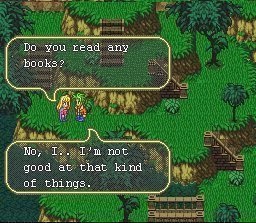
Good old translations (RS3)
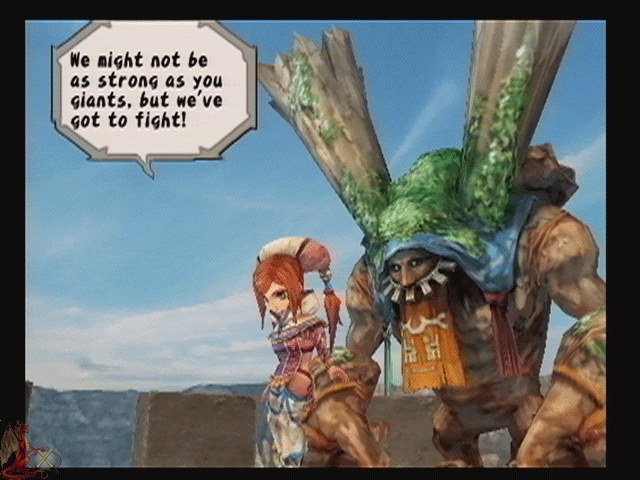
Love the giants (Minstrel Song)
IN A NUTSHELL
SaGa has been praised as open-ended, but it is in fact quite structured. It is a far cry from games like the Elder Scrolls series, where you can literally go anywhere at anytime from the get-go. I always found that pretty lethal to story and fun, since I could just walk away from any person or quest and nothing seemed to matter, while at the same time if I went to the wrong place I would be instantly killed by overpowered enemies.
The SaGa series provides something more like a guided journey that can be completed out of order, continually offering both challenge and discovery.
That is what excites me about the series. Considering that exploring a new world is a key part of what makes RPGs attractive, the SaGa offers some interesting models and approaches to be inspired by.
———————————————
Side note: “Romancing SaGa: Minstrel Song” (PS2) has one of the best intro videos, with music by Masayoshi Yamazaki.
Read more about:
Featured BlogsYou May Also Like